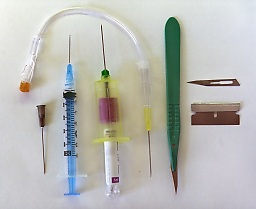| Page 2 |

|
|
1 - Hazardous Waste Management
2 - Page 2 3 - Page 3 4 - Page 4 5 - Page 5 6 - Page 6 7 - Page 7 8 - Page 8 9 - Page 9 |

 HOME
HOME
The term "sharp" is often used as a catch all expression for any and all sharp or pointed items such as broken glassware, scalpel, and razor blades, hypodermic syringes with needles, etc., which can cause cuts or puncture injuries. Sharp waste is subdivided into two categories
- Needle and razor blade waste
- Glassware (and other sharp or pointed) waste
 |
Needle and razor blade waste
contaminated with or containing viable biological agents and trace amounts of hazardous chemical must be disposed in the proper containment box, preferablly like the picture shown on the right:Biological contaminated sharp waste will be labeled as biohazardous waste and disposed of through the University.
Hazardous chemical contaimination will be treated like hazardous waste and disposed of through our contractor, Clean Harbors.
 |
Glassware waste
Any intact or broken glassware such as flasks, beakers, bottles, tubes, pippettes, and micropipette tips. The glassware wastes put be put in disignated plastic-lined boxes.
The waste must not be placed into regular office garbage containers or plastic bags of solid waste. Do not put laboratory glassware into the general recycling bins, its composition may differ from that of recyclable glass containers.
| << Previous 1 [2] 3 4 5 6 7 8 9 Next >> |
